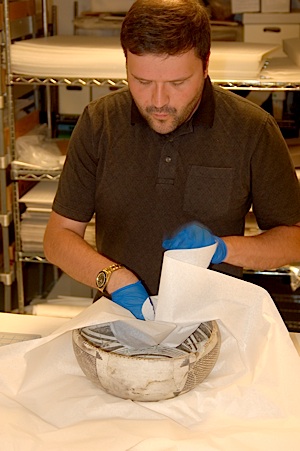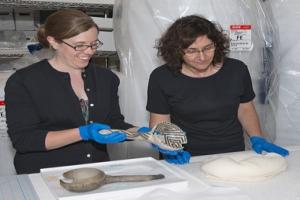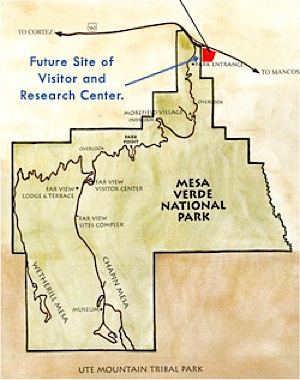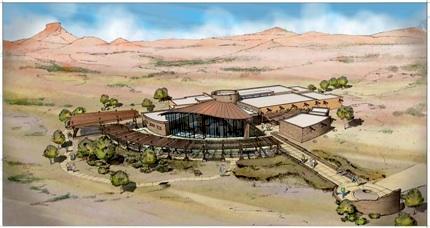A long-held dream of superintendents at Mesa Verde National Park is about to come true. Construction workers are putting the finishing touches on the Mesa Verde National Park Visitor and Research Center, a $12.1 million facility set to open November 26.
Unlike the existing Far View Visitor Center, Mesa Verde’s gateway to the park, the new center is clearly visible as you turn south off U.S. Highway 160, in southwest Colorado. The sleek, low-slung building sits perfectly aligned with Point Lookout, the dramatic butte that announces the park’s entrance.
This means visitors will no longer have to travel 15 miles into Mesa Verde’s interior before learning more about the park’s history and the availability of tickets to its various ruins.
“Now, visitors can find out about tours earlier and they’ll have more options,” notes Mesa Verde’s Superintendent Cliff Spencer.
Long Wait For Funding
Former superintendent Larry Wiese, who headed Mesa Verde for 16 years, worked diligently to make the project a reality, notes Superintendent Spencer, who joined the park in 2010. The move had long been on the wish-list of park administrators, but NPS funding issues frequently stymied progress.
Everyone agreed the new location would better serve the park’s 550,000 annual visitors and consolidate Mesa Verde’s sizeable archival collection. But it took Mr. Wiese’s energy “to get the project on the line-item construction list,” Superintendent Spencer notes. The timing of the project was further benefitted by the availability of federal stimulus money and some Washington connections, namely the tie between Colorado Congressman John Salazar and his brother, Secretary of the Interior Ken Salazar.
The architectural firm AJC worked closely with the park’s 24 Native American tribes to craft a design for the center, which references the adobe style of the Colorado Plateau’s Puebloan people. The spacious center rotunda is a nod to the kiva, a ceremonial space that here functions as a gathering spot for the public to view exhibits or access the facility’s library and repository.
A new bookstore, which will be run by the Mesa Verde Museum Association, completes the facility, says Association Executive Director Laurel Rematore. The 24,000 square-foot building is highly sustainable, and has been submitted for LEED Platinum certification. Additionally, the center will enable the park’s collection of artifacts and records to be stored under one roof.

Eury Cantillo, a museum technician, wraps a Mesa Verde black-on-white bowl in acid-free tissue as the start to the packing process. Photo by Sissy Seeley.
Elements of that collection have been housed in various locations around the park, with the majority of its 3 million artifacts stored in the Tin Shed, a barn-like metal structure.
The Shed was originally built in the 1960s as a temporary field lab for the processing of pottery, sherds, and other artifacts unearthed during the Wetherill Mesa Archaeological Project, 1958-1965, one of the largest archaeological digs ever conducted in the U.S. It later became a park repository.
But the Shed’s location, out on Chapin Mesa, makes it susceptible to extreme weather conditions and to fire. In fact, it was nearly damaged during a park fire in 2002. The space also provides little room for researchers to work.
In the new facility, scholars will have access to lab space, a library, and study carrels. The public will also gain a window into the research world, as the center’s design allows for visitors to peer into processing rooms where they can observe archaeologists at work.
Eegad! Logistics Challenge
Of course, safely inventorying, analyzing, packing, and moving 3 million artifacts a distance of some 20 miles doesn’t happen overnight. To find answers to this logistics puzzle, Mesa Verde’s museum curator, Tara Travis, turned to conservators with the NPS’s Intermountain Region Museum Services, who assist curators on museum collection relocations.
“It’s been daunting and a challenge,” notes Ms. Travis. “But the upside has been seeing the collection.
“I started a year ago planning to move the artifacts. Now I’m working on packing up the material,” she says, a task that will take her, a museum technician, and six volunteers three years to complete.

Lauren Finn, Museum Technician, tilts the ladle so Tara Travis, museum curator, can hear the rattle sound that emanates from the rattle handle. NPS photo by Robert D. Jensen.
In between handling and wrapping ancient objects there have been magical moments, too. Earlier this summer, Ms. Travis says they were packing a black and white ceramic ladle when they discovered its hollow center held beads. When tipped, it sounded liked a rain stick.
“Everyone packing stopped when we all heard the tinkle. To hear that sound was a special moment in the packing process,” she says.
Additionally, Ms. Travis has overseen the digitization of the park’s extensive herbarium collections, which dates back to excavations from the 1920s. “This is extremely fragile because it’s pressed plants. Digitizing makes them more accessible to researchers,” she says.
The collection is now available through the Southwest Environmental Information Network, an online gateway for information about the flora and environment of the Southwest.
Far View’s Future
Fall visitors to Mesa Verde will have a few more weeks to admire the Far View Visitor Center before the park permanently closes its doors on October 20.

NPS graphic.
The building first opened to the public in 1968 and was part of the NPS’s Mission 66, an effort to better accommodate increasing visitation of the nation’s parks.
The Mesa Verde Foundation, a philanthropic nonprofit, is now working closely with tribes affiliated with the park to develop a Tribal Cultures Center and Dance Plaza. The refurbished center will celebrate the tribe’s contemporary cultures through visual and performing arts while providing a link to their ancestral past.
To learn more, visit the Foundation’s website.
Traveler footnote: The grand opening will take place May 23, 2013.




Add comment